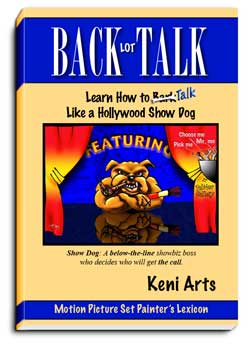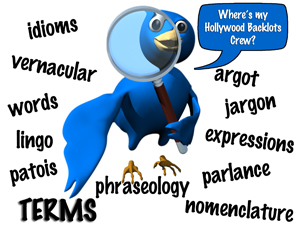[su_row]
[su_column size=”1/3″] [/su_column]
[su_column size=”1/3″]
‘Making it’ in Hollywood depends on several important factors; who you know, what you know and even…what you say. If a production assistant tells an A-list actress that she can get dressed in the Honey Wagon, that assistant’s career might be cut very short, very fast.
Back Lot Talk contains the lexicon of the set painter, but it will also help anyone who wants to grasp the exoteric film-speak language. With a little learning, you can effectively communicate with the big dogs of the industry.
[/su_column]
[su_column size=”1/3″]
In his book, Back Lot Talk, Keni defined over 130 terms used in the motion picture and television industry. There are also over 25 original drawings in the book.
- Bonus: Breaking into show business essay.
Take a look inside
Click on the ‘Paperback button’ and you will be taken to Amazon where you can see a sample of the book before making a purchase.
[su_button url=”http://goo.gl/xIXBAu” target=”blank”]Paperback[/su_button]
[su_button url=”http://goo.gl/78EOW6″ target=”blank”]E-book[/su_button] [/su_column] [/su_row] [su_divider top=”no”]
There are other related terms iconic of the broader entertainment industry.Here are additional ones that didn’t make it into the book.
If you are affiliated with the Hollywood entertainment industry, you are invited to *add to the moderated list below. Use the ‘Comment’ box below. We’ll be happy to give you contributor credit for each term you submit which is used on this site. Don’t forget to include your name if you want screen credits.
* * *
Additional Terms
Prop A laptop, lamp, fountain pen, etc. that serves as an accessory on a set . A ‘prop’ is often considered ‘set dressing’ when it is not handled by an actor.
Action Prop A prop (laptop, lamp, fountain pen, etc.) that will be handled by an actor on camera.
Below-the-Line Defined in Back Lot Talk
Crack and Peal: To make a new paint job look very old, such as might be seen on the exterior of a very old painted barn. This is often achieved by using various combinations of hot shellac, silicate of soda, corn starch and alki.
Crack the Hudson A hudson is a 3 gallon hand sprayer. It is pressurized by pumping a handle located on its top. To ‘crack the hudson’ is to relieve the pressure by slowly depressing the handle and turning it counter clockwise. Contributor – Jake Lagos.
Dairy Run: Early each morning at the start of a work shift (usually 6:00 AM), a laborer would ride a bicycle off the studio lot to the nearest liquor store on their daily ‘dairy run’. The dairy product was some form of alcoholic beverage and ice. This ritual no longer continues; at least not formally. Contributor — H.G. Also see ‘Sweaty Bucket’ in Back Lot Talk.
Distress: To make old. An example would be to put dents and scratches on new wood. This is often done by beating the wood with a large chain attached to a handle or by using a surf form to knock the sharp edges off the wood.
Dutch Cut (aka: Double Cut): When hanging wall paper, it is sometimes necessary to hang, overlap and cut through two sheets of paper in order to match the pattern in the or make the seam ‘go away’. The person making the cut may choose to use a straight edge or might decide to make a gradual ‘S’ curve down its edge. Contributor – Cliff Berns
Gang boss: A gang boss is typically a supervisor who has the responsibility of managing a portion of workers in their department. They might have the responsibility to complete only one of many sets on a show, or all of the sets on one stage. They work under the lead foreman and their second. As you would expect, the gang boss has a slightly higher pay rate than the other crew members, thus comes the desire for crew members to get ‘the rate’. Also see ‘Rate’ in Back Lot Talk.
Get Hot: Pick up the pace or get stuff done faster. Contributor – Cliff Berns
Greens: Defined in Back Lot Talk
Hot Batch: A fresh pot of coffee. Contributor – Cliff Berns
Jump the shark: In the television series, ‘Happy Days’, Fonzie (Henry Winkler) accepted a challenge to jump over a shark on water skis. Several years after the airing of the show, ‘jump the shark’ morphed into meaning that a show had reached its peak and that it was all downhill from that point forward.
IATSE: Defined in Back Lot Talk
It’s Only Water: Painters occasionally find themselves using spray equipment on a set with other workers. Often one of the materials being sprayed is water. They might also be using a chimical that could be harmful if inhaled or if it comes into contact with the skin. If a painter has a combination of materials and they accidentally spray another worker, their first response is often, “It’s only water”. Contributor — C.S.
Iron Sulfate:Iron sulfate is a chemical compound many homeowners may recognize as a lawn conditioner. However, for a studio painter, it is often used to treat metal. When mixed with water, it can be sprayed or brushed on metal to quickly produce a corrosion or rust effect. Contributor – Dave Valdes
Peel Paint Peel paint does as the name implies; it can be peeled from a surface on which it was applied. Peel paint is frequently used on ‘picture cars’ to temporarily change its color. For example, a green car and be made to be red by first spraying a heavy coat of peel paint, then a gloss red over it. After the car has been filmed, the paint is peeled off to return the car to its original color.
Plant-on: An example of a plant-on would be the doors on kitchen cabinets which are nailed shut and have no hinges. They give only the appearance of being practical.
Plug: A non-functioning part of the set. For example, ome doors in a set may be ‘plugs‘ (without hinges and nailed shut). Contributor – Chuck
Practical: A functioning part of the set. For example, doors which can be used by actors to pass in and out of the set are practical. Contributor – Patrick
Propmaker: A member of IATSE local #44 whose primary responsibility is to build sets for movies and television. They might also do other construction work and fine carpentry.
Putty, plaster, caulk and paint makes a propmaker what he ain’t. This humorous term was given by a propmaker. There are many talented and skilled propmakers working in show business but sometimes they get the adage of ‘measure twice, cut once’ backward. Then the adage, ‘The painters will fix it’ is the solution.
Run the Table: Defined in Back Lot Talk
Sag Card: “Are you working on your SAG card?’ In the ‘above-the-line’ parlors of Hollywood, the Screen Actors Guild (SAG) is the coveted membership card in the distinguished performers union. In the ‘below-the-line’ haunts of the painter’s union, the ‘sag’ distinction is not so distinguished. The question is a way to tease a painter for applying so much paint that is sags and drips. Contributor – Patrick
Sauce: A thinned material (either oil or water based) used to glaze a portion of the set. Contributor – Cliff Berns
Scumble: Studio rocks are seldom rocks. They are usually made of plaster or some form of light weight material. A freshly painted rock will usually need to be ‘aged down’ in order to appear natural. Therefore the painter will ‘scumble’ (not scrumble) thin washes of earth-tone colors over the rocks to give it a natural ‘worn’ look. Contributor – Cliff Berns
Straight Edge: A tool used most often in wall papering. It ranges in length of approximately 4′ to 6′ long and is about 3″ wide by 1/2″ thick. It is light weight and has channels running down its length. Many have a slight bow along its length. This allows the ends of the straight edge to lay firmly on the table. When the person running the table to presses down on the on the center of the straight edge the paper is held firmly, allowing for a straight cut.
Studio Zone: The area within a circle thirty miles in radius from Beverly Blvd. and La Cienega Blvd in Los Angeles California.
Translight: An enormous photograph, often stitched together from a series of photos, to create a film backing typically used as a backdrop in the film and TV industry.  Scenic Artist Defined in Back Lot Talk
Scenic Artist Defined in Back Lot Talk


